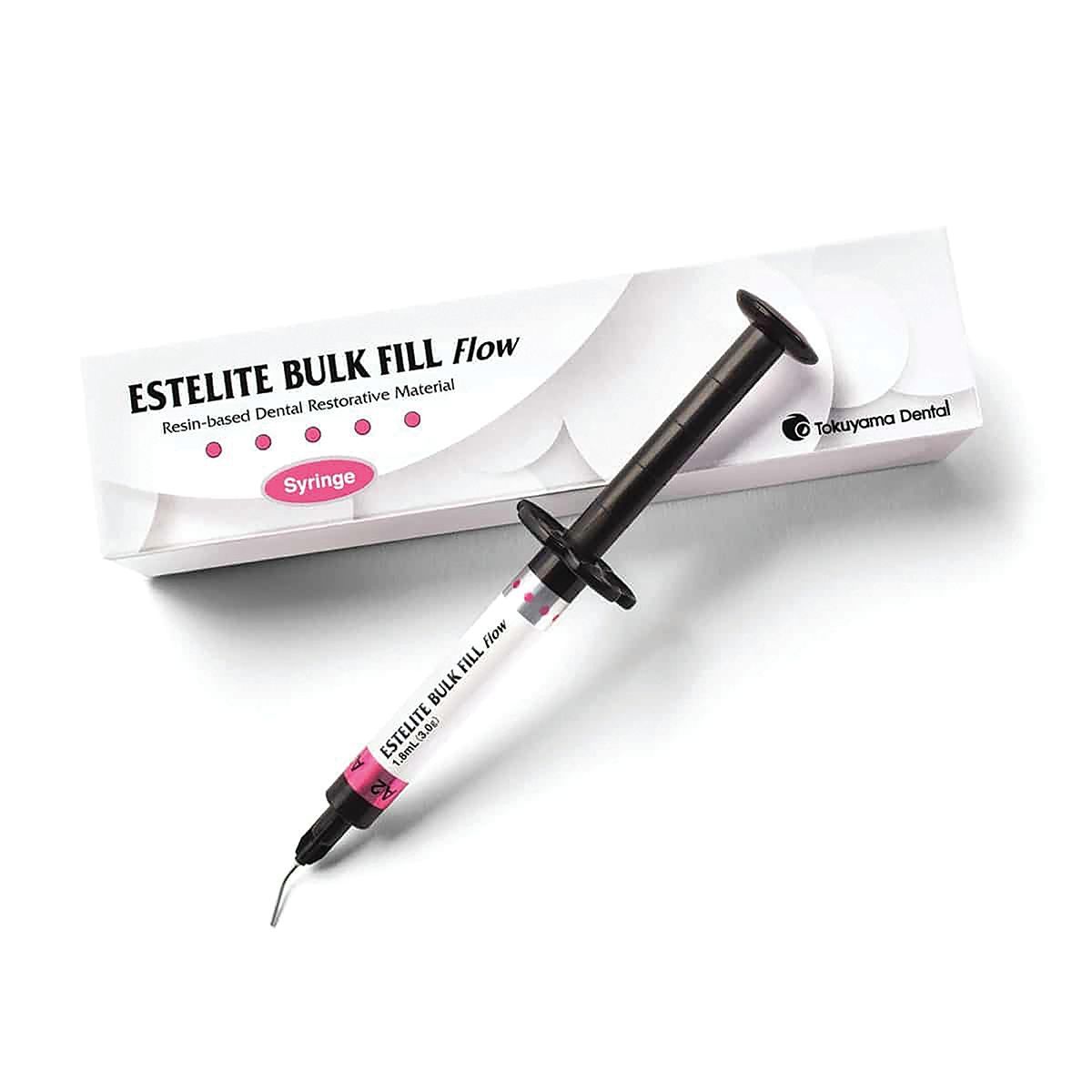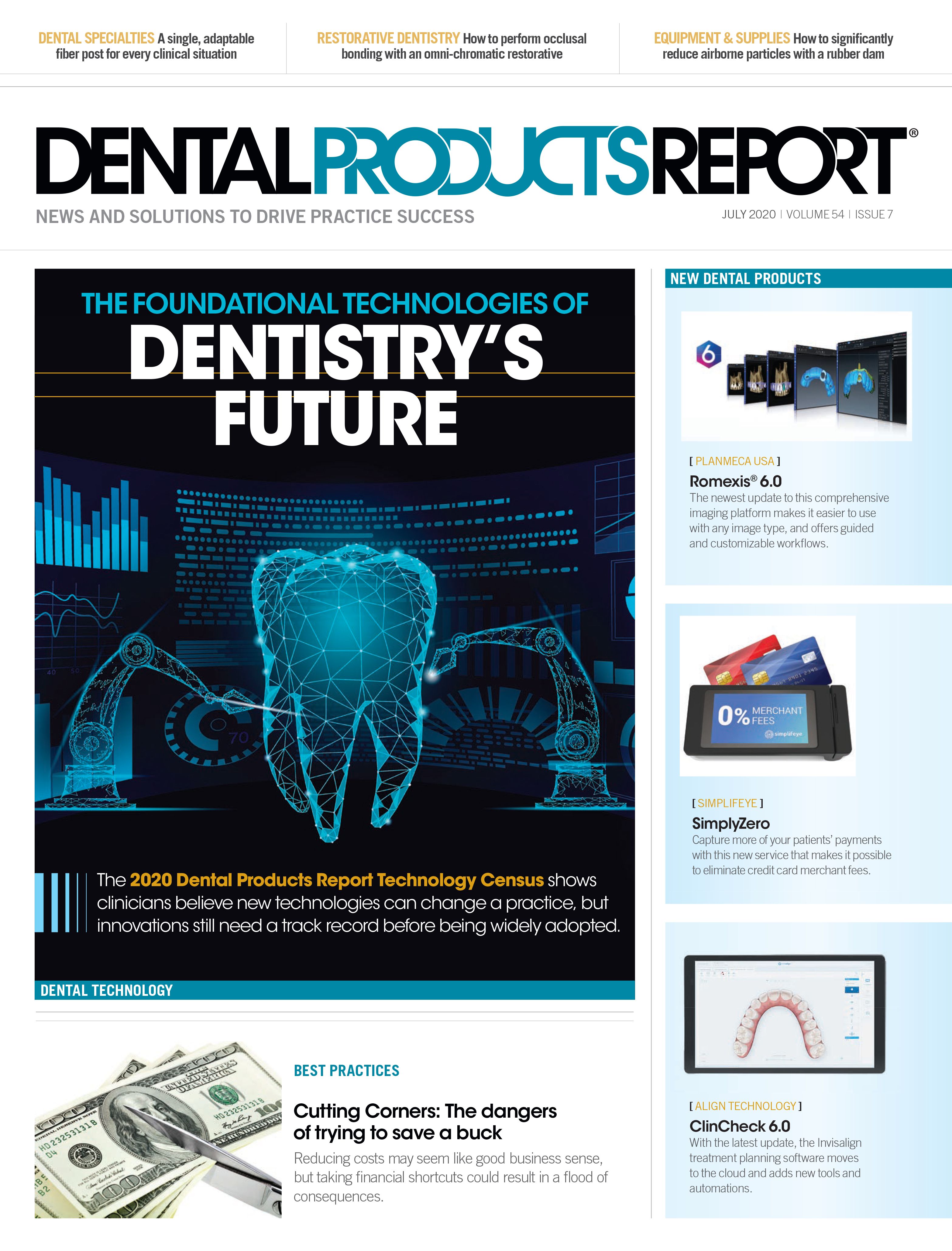Clinicians have used bulk fill flowable composite resins for several years. These were traditionally designed as a dentin replacement only, requiring an enamel layer to withstand occlusal function and wear because of limitations in the physical properties of the material. Dentists largely agree that flowable resins, in general, increase the potential for precise marginal adaptation, with a lower viscosity compared with conventional paste composites. Therefore, the line angles and point angles of cavity preparations lined or filled with a flowable composite restorative material may have a reduction in the potential for marginal failure from microleakage.1
Bulk fill technologies have been developed to decrease the need to layer with traditional materials, whose clinical performance can diminish because of polymerization shrinkage and/or depth of cure issues.2-6 Because most dentists have had on their wish list a composite material that behaves like amalgam, a single, bulk fill material would be beneficial and welcome. Thanks to a unique filler technology now used in a flowable composite material, a bulk fill flowable restorative material has the physical strength to make capping with traditional composites a thing of the past.
The Importance of Fillers in Composite Resins
The size and shape of fillers in composite materials have a direct bearing on the physical properties of the material. The higher the filler load, the closer the fillers can be packed together, minimizing the amount of resin between each particle and leading to higher strength, better optical properties, and better polishability.
Uniformly sized spherical fillers with an average diameter of 200 nm produce a composite material that, not only has excellent physical properties and wear resistance, but is also highly polishable. The wear on the material from the opposing dentition is virtually zero. Because of the uniform shape of the spherical fillers, they can rotate and move during photopolymerization. The result is less potential polymerization shrinkage and less microleakage between the restoration interface and the tooth.7-9
An Evolution in Bulk Fill Flowable Composite Resins
With the introduction of Estelite Bulk Fill Flow from Tokuyama Dental America, a new class of bulk fill flowable composites arrived in 2019 and a revolutionary change occurred in how clinicians use bulk fill flowables. They eliminated the need for a traditional nanohybrid capping layer as the final increment of the restoration. According to the manufacturer, the spherical nature of the fillers in the material allows for an increase in physical properties and esthetics (particularly opacity), the main reason traditional flowable composites have been indicated for dentin replacement only. For Estelite Bulk Fill Flow, the supranano spherical fillers are made of silica-zirconia produced by the sol-gel method at a mean particle size of 200 nm.
Estelite Bulk Fill Flow
- Utilizes spherical filler technology for superior final results
- No capping layer needed
- Up to 4 mm curing depth
- Lower wear and abrasion for restorations that last
- Higher cavity adaptation prevents gaps and voids
Tokuyama Dental America, Inc.
877-378-3548 | tokuyama-us.com
Because of their uniform geometry, these supranano-sized filler particles can be closely compacted in the resin matrix to increase the quality of the physical properties (wear resistance, compressive, and tensile strength) of the material. Also, they allow for a higher diffusion and refraction of light that penetrates into the material itself. This allows for a more predictable depth of cure and increases the material’s ability to blend esthetically with the adjacent tooth structure.
Estelite Bulk Fill Flow is also unique because it is more translucent at placement, to allow for depth of cure of up to 4 mm. Then, during photopolymerization, the material becomes more opaque to better match the optical properties of the surrounding tooth structure (enamel). When photopolymerization is finished, clinicians can quickly achieve a high degree of polish, as the spherical fillers, with an average size of 200 nm (supranano), create a smooth surface and will maintain high luster. Abrasion and “plucking” will not affect the quality of the reflectivity and shine for years.
A Class III Anterior Restoration Using a Bulk Fill Flowable Composite
A class III distal composite shown in tooth number 7 (Figure 1) has evidence of marginal leakage and is in need of replacement.
The composite material and any existing recurrent decay are removed using a 330-carbide bur from SS White Dental while protecting the adjacent surface with a WedgeGuard from Ultradent Products (Figure 2). An anatomically contoured mylar Bioclear Matrix from Bioclear is placed, and the gingival margin of the preparation is sealed using an interproximal wedge such as those from Bioclear or the DualForce Wedge from Clinician’s Choice.
The preparation is selectively etched on the enamel periphery using 37% phosphoric acid for 15 seconds and then rinsed with water. The enamel is dried with air, and then the bonding agent, Tokuyama Universal Bond from Tokuyama Dental America, is placed on both enamel and dentin with a microbrush.
The selected shade (A2) of Estelite Bulk Fill Flow is then placed into the cavity preparation (Figure 4). A sable brush is used to gently remove any minimal excess and ensure the cavity margins are covered.
It is crucial to emphasize the importance of a properly fitted anatomic matrix to limit any potential excess material as it is placed into the preparation. The goal should be as little rotary finishing and contouring as possible.
After light curing the composite per the manufacturer’s instructions, the matrix system and isolation are removed, and the finishing process can begin. Proximal contacts are easily adjusted (Figure 5) using different grits of the ContacEZ Restorative Strip System from ContacEZ. This strip system combines efficient precision contouring of all proximal surfaces of composite restorations (anterior and posterior) with the ability to maintain the proper anatomic contour (convex), which can be difficult to impossible to achieve with traditional diamond abrasive strips because of access limitations. In addition, the serrated edge helps gain access to the interproximal of a recently finished composite restoration should bonding resin be inadvertently polymerized during placement, blocking the occlusal embrasure and access to the interproximal area for the instrument and to dental floss.
Lastly, final polishing of the restoration is achieved using rubber composite polishing instruments such as A.S.A.P. All Surface Access Polishers fromClinician’s Choice (Figure 6). Figure 7 shows a post-operative view of the completed restoration from the occlusal aspect. Note the extremely high luster achieved and how nicely the restorative material blends into the surrounding tooth structure. Figure 8 shows a 2-year follow-up on the placement of the restoration.
A Class II Posterior Restoration Using a Bulk Fill Flowable Composite
A class II DO composite shown in tooth number 12 (Figure 9) has a fractured marginal ridge and is in need of replacement.
The remaining composite material and any existing recurrent decay is removed using a 330-carbide burwhile protecting the adjacent surface with a WedgeGuard (Figure 10).
Once removal of the existing restoration is complete, the quadrant is isolated with an Isolite from Zyris and DryTips from Microbrush International to cover the Stensen (Parotid) duct. Next, a DualForce sectional matrix from Clinician’s Choice is placed around the completed cavity preparation (Figure 11).
The preparation is selectively etched onto the enamel periphery using 37% phosphoric acid for 15 seconds and then rinsed with water. The enamel is dried with air, and then Tokuyama Universal Bond is placed on both enamel and dentin with a microbrush (Figure 12).
The selected shade (A2) of Estelite Bulk Fill Flow is then placed into the cavity preparation (Figure 13). A sable brush is used to gently remove any minimal excess and ensure the cavity margins are covered. Because a capping layer is not required with Estelite Bulk Fill Flow composite, the cavity preparation is completely filled to the cavosurface margin and the top of the matrix band in the interproximal area.
Again, I emphasize the importance of a properly fitted anatomic sectional matrix to limit any potential excess material as it is placed into the preparation. The goal should be as little rotary finishing and contouring as possible. After light curing the composite per the manufacturer’s instructions, the matrix system and isolation are removed, and finishing can begin.
The occlusal contacts are checked with articulating paper (Figure 14) and adjusted as needed using a needle or a mosquito-type composite diamond finishing bur such as the #8392.016; from Komet USA (Figure 15).
Next, the restoration is polished using A.S.A.P. All Surface Access Polishers from Clinician’s Choice (Figure 16). The Restorative Strip System from ContacEZ is used to remove any excess resin bonding material and refine the interproximal contours as needed to make sure dental floss can slide cleanly through the contact area (Figure 17).
Figure 18 shows a post-operative occlusal view of the completed restoration. Note the extremely high luster achieved and how the restorative material blends into the surrounding tooth structure. Figure 19 shows a 2-year follow-up on the placed restoration.
Conclusions
For many years, clinicians have longed for composite restorative materials with a more simplified, less technique-laden approach to clinical placement. A bulk fill flowable composite offers the benefit of accurate adaptation to the cavity preparation while eliminating the need for incremental placement and condensation (plugging).
Estelite Bulk Fill Flow goes one step further by eliminating the need for an enamel capping layer so cavity preparations of 4 mm or less can be filled entirely with one increment of bulk fill flowable composite. Given the high polishability from the presence of spherical fillers, as well, Estelite Bulk Fill Flow offers the clinician a high-quality restorative option for a variety of clinical applications and is showing excellent long-term clinical results.10
References
Ilie N, Bucuta S, Draenert M. Bulk-fill resin-based composites: an in vitro assessment of their mechanical performance. Oper Dent. 2013;38(6):618-625. doi:10.2341/12-395-L
Campodonico CE, Tantbirojn D, Olin PS, Versluis A. Cuspal deflection and depth of cure in resin-based composite restorations filled by using bulk, incremental and transtooth-illumination techniques. J Am Dent Assoc. 2011;142(10):1176‐1182. doi:10.14219/jada.archive.2011.0087
Rees JS, Jagger DC, Williams DR, Brown G, Duguid W. A reappraisal of the incremental packing technique for light cured composite resins. J Oral Rehabil. 2004;31(1):81‐84. doi:10.1046/j.0305-182x.2003.01073.x
Flury S, Hayoz S, Peutzfeldt A, Hüsler J, Lussi A. Depth of cure of resin composites: is the ISO 4049 method suitable for bulk fill materials? Dent Mater. 2012;28(5):521‐528. doi:10.1016/j.dental.2012.02.002
El-Safty S, Silikas N, Akhtar R, Watts DC. Nanoindentation creep versus bulk compressive creep of dental resin-composites. Dent Mater. 2012;28(11):1171‐1182. doi:10.1016/j.dental.2012.08.012
Roggendorf MJ, Krämer N, Appelt A, Naumann M, Frankenberger R. Marginal quality of flowable 4-mm base vs. conventionally layered resin composite. J Dent. 2011;39(10):643‐647. doi:10.1016/j.jdent.2011.07.004
Rüttermann S, Wandrey C, Raab W H-M, Janda R. Novel nano-particles as fillers for an experimental resin-based restorative material. Acta Biomater. 2008;4(6):1846‐1853. doi:10.1016/j.actbio.2008.06.006
Lee JH, Um CM, Lee IB. Rheological properties of resin composites according to variations in monomer and filler composition. Dent Mater. 2006;22(6):515‐526. doi:10.1016/j.dental.2005.05.008
Yuasa S. Composite oxide spherical particle filler. DE J Dent Eng. 1999;89:33-36.

